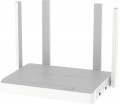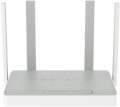Wireless speed 2.4 GHz
The maximum speed provided by the device when communicating wirelessly in the 2.4 GHz band.
This range is used in most modern Wi-Fi standards (see above) - as one of the available or even the only one. The theoretical maximum for it is 600 Mbit. In reality, Wi-Fi at a frequency of 2.4 GHz is used by a large number of client devices, from which congestion of data transmission channels emerges. Also, the number of antennas affects the speed performance of the equipment. It is possible to achieve the speed declared in the specification only in an ideal situation. In practice, it can be noticeably smaller (often by several times), especially with an abundance of wireless technology simultaneously connected to the equipment. The maximum speed at 2.4 GHz is specified in the characteristics of specific models to understand the real capabilities of Wi-Fi equipment. As for the numbers, according to the capabilities in the 2.4 GHz band, modern equipment is conditionally divided into models with speeds
up to 500 Mbit inclusive and
over 500 Mbit.
Wireless speed 5 GHz
The maximum speed supported by the device when communicating wirelessly in the 5 GHz band.
This range is used in Wi-Fi 4, Wi-Fi 6 and Wi-Fi 6E as one of the available bands, in Wi-Fi 5 as the only one (see "Wi-Fi Standards"). The maximum speed is specified in the specifications in order to indicate the real capabilities of specific equipment - they can be noticeably more modest than the general capabilities of the standard. Also, in fact, it all depends on the generation of Wi-Fi. For example, devices with Wi-Fi 5 support can theoretically deliver up to 6928 Mbit (using eight antennas), with Wi-Fi 6 support up to 9607 Mbit (using the same eight spatial streams). The maximum possible communication speed is achieved under certain conditions, and not every model of Wi-Fi equipment fully satisfies them. Specific figures are conditionally divided into several groups: the value
up to 500 Mbit is rather modest, many devices support speeds in the range of
500 - 1000 Mbit, indicators of
1 - 2 Gbps can be attributed to the average, and the most advanced models in class provide a data exchange rate of
over 2 Gbps.
WAN
The WAN port characterizes the ability of the device to receive a wired signal. There may be models with both one port and
two WAN ports, and in rare cases, more connected providers. Such an expanded number of WAN connectors affects the cost and, accordingly, is found in more part among professional-level routers.
In terms of speed, when choosing a device, the priority is the speed of the output LAN port or Wi-Fi. However, faster WAN ports (
1 Gbps,
2.5 Gbps,
5 Gbps,
10 Gbps) allow you to divide the load on several outputs at once without reducing speed performance, as may be the case with
WAN port 100 Mbps.
LAN
In this case, LAN means standard network connectors (known as RJ-45) designed for wired connection of LAN devices — PCs, servers, additional access points, etc. The number of ports corresponds to the number of devices that can be directly connected to wired equipment. way.
In terms of speed,
100 Mbps (Fast Ethernet) and
1 Gbps (Gigabit Ethernet) are the most popular options today. At the same time, thanks to the development of technology, more and more gigabit devices are being produced, although in fact this speed is critical only when transferring large amounts of information. At the same time, some models, in addition to the standard speed of the main LAN ports, may have
a 2.5 Gbps, 5 Gbps and even 10 Gbps LAN port with increased bandwidth.
Reassignable WAN / LAN
Reassignable WAN / LAN port in the design of the device, which can work both with an external WAN network and with a local LAN. This solution allows you to reduce the total number of connection ports and at the same time expand the functionality of the equipment for flexible adaptation to user needs.
USB 2.0
The number
of USB 2.0 ports provided in the design of the device.
USB in this case plays the role of a universal interface for connecting peripheral devices to the router. The specific USB devices supported and how they are used may vary. Examples include working with a flash drive that plays the role of a drive for working in FTP or file server mode (see "Functions / Capabilities"), connecting to a printer in
print server mode(see ibid), connecting a 3G modem (See "Data input (WAN-port)"), etc.
Specifically, USB 2.0 allows you to transfer data at speeds up to 480 Mbps. This is noticeably less than that of more advanced standards (starting with USB 3.2 gen1 described below), and the power supply of such connectors is low. However, even such characteristics are often quite enough, taking into account the specifics of the use of Wi-Fi devices. In addition, peripherals for newer versions can also be connected to the USB 2.0 port — the main thing is that the power supply is enough. Therefore, although this standard is considered obsolete, it is still widely used in modern wireless equipment. There are even models that provide
2 or even more USB 2.0 ports; this allows you to simultaneously use several external devices at once — for example, a 3G modem and a USB flash drive.
CPU
The model of the processor installed in the device.
The processor is responsible for processing network traffic and running software. Knowing its name, you can get more detailed data on the speed capabilities of the equipment and understand how much such a powerful or, on the contrary, mediocre element is needed on board. In new models of Wi-Fi equipment, coprocessors or so-called NPU modules are often installed, which relieve the load from the main processor.
Most often, Wi-Fi equipment is equipped with processors from
Broadcom,
MediaTek,
Realtek and
Qualcomm.
Clock Speed
The number of cycles per second that the processor produces in its normal operating mode. A clock is a single electrical impulse used to process data and synchronize the processor with the rest of the computer system. Different operations may require fractions of a clock or several clocks, but anyway, the clock frequency is one of the main parameters characterizing the performance and speed of the processor — all other things being equal, a processor with a higher clock frequency will work faster and better cope with significant loads.
RAM
The amount of random access memory (RAM) provided in the device. The amount of "RAM" is one of the indicators of the power of the device: the larger it is, the higher the speed and the better the device will cope with "heavy" tasks. Among the values, there can be
128 MB,
256 MB,
512 MB and high scores in
1 GB and
2 GB.

